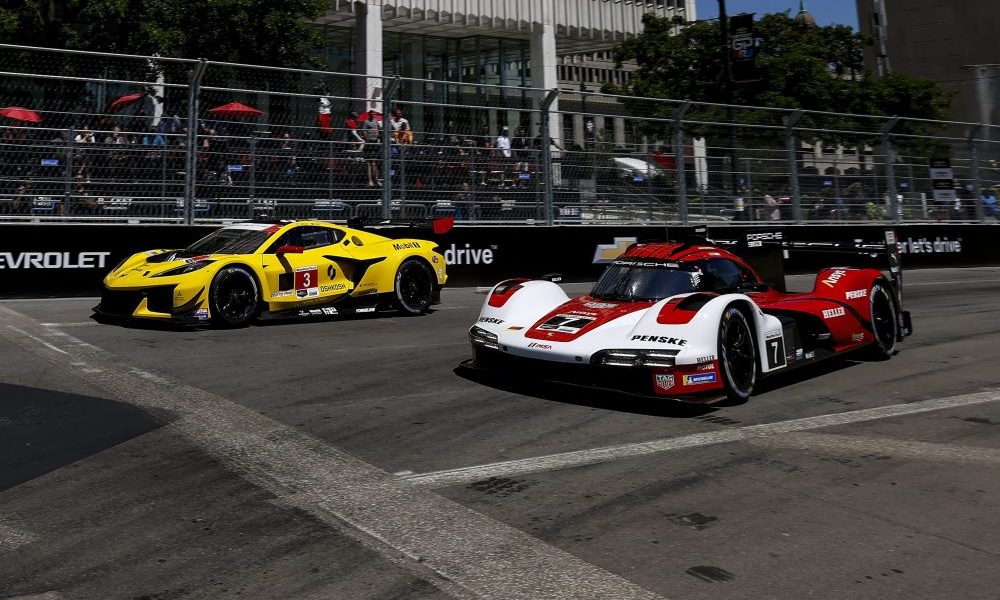Today’s second super sprint race, the 100-minute Chevrolet Sports Car Classic, is round five of the IMSA WeatherTech SportsCar Championship. The short duration both makes strategy a bit simpler and trickier at the same time.
With both the GTP and GTD PRO machinery able to make more than half distance on fuel, only a single pit stop is necessary. But having only one stop makes the timing of that stop much more critical.
There’s also the tire question. Long Beach winners Sebastien Bourdais and Renger van der Zande did the entire race on a single set of tires. Forgoing a tire change allowed the out lap on hotter tires to be just enough quicker to make the difference. The same happened last year at Long Beach. The consensus so far is that Detroit is a very low-energy circuit, making running the full race on a set of tires possible, and in the case of the GTP cars, likely desirable. Expect most GTP teams to not take tires, or only two, trading ultimate grip at the end of the race for track position and hot tires in the middle.
GTP teams have three sets of tires to use between practice and qualifying. GTD PRO teams have an allotment of four sets for the event.
Proton Competition leads warmup
All the teams participated in the 20-minute warmup – officially termed “Practice 3” – on Saturday morning that fortunately was incident-free, although one car did lose a chunk of bodywork on the Jefferson Ave. straight. Gianmaria Bruni posted the top time in GTP in the No. 5 Proton Competition Porsche 963 at 1m5.899, nearly half a second better than the car did in qualifying yesterday. Ricky Taylor was second in the No. 10 Wayne Taylor Racing with Andretti Acura ARX-06, followed by polesitter Nicky Tandy in the No. 6 Porsche Penske Motorsport 963.
Antonio Garcia, the GTD PRO polesitter for today’s race, was quickest in the warmup in the No. 3 Corvette Racing by Pratt Miller Motorsports Z06 GT3.R, about half a second slower than he did in qualifying. Daniel Serra followed in the No. 35 Conquest Racing Ferrari 296 GT3, and Laurin Heinrich in the No. 77 AO Racing Porsche 911 GT3R was third.
Don’t pass me here
Detroit is proving to be a bit of a mystery in regards to how traffic may play out, but even within the narrow confines of a street circuit, it may not be much of an issue. Because all the corners are tight and given the size of the GTPs vs. the GT3 cars in GTD PRO, the GTP drivers are reporting that the GT cars are really not much slower in the corners, and sometimes even a bit faster. Most of the 4-5 second gap in lap time is coming on the straights thanks to the better acceleration and higher top speed of the GTPs.
But as the race winds down and GTP drivers are looking to put GT cars between themselves and any pursuers at every opportunity, things could get dicey. And the GT drivers definitely have a preference of where things do, and don’t, get aggressive.
“Once things get a little bit intense, they will start to dive bomb a little bit more,” explains GTD PRO polesitter Antonio Garcia. “So I reckon if they have good exit at 3, they will probably try to pass into 4. I hope there is no passing between 4 and 7. But then, if they have good runs, they can definitely pass into 8, Turns 1, 3, and the question mark will be 4 and 5. So yeah, it can be very very tight there.
“I’m sure initially we will all respect each other and everything will be kind of cool and mild. But once everything goes to the end and I’m sure all the GTP cars will want to put some GTs in the middle so that that’s when some of the dive bombs will come.”

Split pit and start/finish
A unique feature of the downtown Detroit circuit is the split pit lane. A shorter pit lane in length is compensated by having two separate pit lanes on either side. The WeatherTech Championship split is GTP on drivers’ right, GTD PRO on the left.
Another unusual aspect of the Detroit circuit is the split start and finish. Because the pit straight is rather short, races are started on the long Jefferson Ave. straight between Turns 2 and 3 so that the full field can be on the straight and see the starter. Thus, “Turn 1” for the race start is actually Turn 3, a big-brake-zone, tight, 180-degree hairpin..
Drive time
With only Pro classes in this event, minimum drive time is 10m.
Previous winners
Of course, the last time the IMSA WeatherTech SportsCar Championship raced in Detroit, it was on the Belle Isle circuit in 2022, so previous winners may not be much of an indication as to who could star in this race, especially since that race’s prototypes were DPi machines as opposed to the current GTPs.
It is worth noting, though, that the teams that won the 2022 version of Detroit both also excelled at Long Beach this April. Renger van der Zande and Sebastien Bourdais took the 2022 Detroit victory in the No. 01 Cadillac Chip Ganassi Racing Cadillac DPi-V.R, while Ben Barnicoat and Kyle Kirkwood won GTD PRO in the Vasser Sullivan Lexus RC F GT3.
How to watch and listen
The race will be broadcast live on USA Network with flag-to-flag coverage beginning at 3 p.m. ET, as well as streamed on Peacock. Leigh Diffey and Calving Fish provide commentary while Marty Snider and Dillon Welch tackle the action in the pits. John Hindhaugh and Jeremy Shaw, with Shea Adam in the pits, will keep IMSA Radio listeners informed on IMSA.com and RadioLeMans.com. SiriusXM race coverage begins at 3 p.m. on XM 206, SiriusXM Web/App 996
